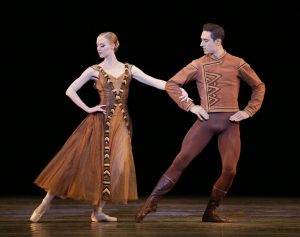New York City Ballet MOVES with Miriam
Iowa City’s own Miriam Miller performs as a part of New York City Ballet
Performers from New York City Ballet graced the audience with MOVES, a selection of pieces choreographed by various artists on Oct. 24-25 at Hancher Auditorium. It was New York City Ballet’s first time at Hancher, and the star of the show was Miriam Miller, a dancer from Iowa City and former West High student. Miller danced the lead role in After the Rain, a piece choreographed by the acclaimed Christopher Wheeldon. She decided to perform for a hometown crowd instead of accepting her Princess Grace Award in California. Miller was happy to be back, “Dancing in Iowa City was very special. I loved being able to share a preview of NYCB with my hometown and to hopefully help my family and friends understand what it is that I do out in New York. As well as show young dancers that their dreams are completely reachable.”
The theme of the night seemed to be symmetry, with many of the movements mirrored and repeated in each dance. The first piece, In the Night, was what could be considered more classical ballet. It was a swirl of romantic tutus and automnal colors. In the Night was set to the music of Chopin and was split into three individual pas de deux that had their own personality. West High student, Greta VandeLune ‘20, saw the ballet. “I thought the performance was really beautiful and creative; every piece had its own story and it was really cool trying to figure them out,” said VandeLune.
La Stravaganza, the second piece, was the most out of the box of the five dances. It mixed contemporary elements with those of 17th century society. The score was Vivaldi and electronic sound bytes that made for a haunting, dystopian scene. The curtain rises to reveal six dancers making up a natural, flowy forest; then the dance moves on with the addition of six more dancers whose movements are more angular and urgent. The two groups meet each other with curiosity and from there the two styles meld into a mixture of both fluidity and urgency. The piece ends as it begins, with the flowing forest. “My favorite was probably La Stravaganza, the second piece… I think it [the piece] is a lot like our society today [different groups],” VandeLune said.

Another detail of the night was having the musicians on stage. In Sonatine, the dancers were accompanied by a single piano. Sonatine was a flowing, bright and majestic piece, with a calming effect. The backdrop and costumes were all blue, adding to the feeling of peace. The sounds of the dancers breathing in all the pieces, but especially Sonatine added a personal aspect to the dance.
After the Rain washed over the audience like a gentle breeze. People sat still in their seats, watching the performance in suspense. The dance was simple and bare with the same repetition of the other dances. After the Rain was performed by Miller and a principal dancer, Adrien Danchig-Waring. “It was such a dream to dance as I have memories of watching the most iconic ballerinas dance it. The music gives me chills and the mood of the piece is calm and serene,” Miller said.
As they took their bows, the audience gave them a standing ovation. Millers former teacher, Sarah Barragán saw the performance both nights. “It was wonderful to see her in a contemporary ballet, everything I have seen her perform with NYCB has been classical and in pointe shoes. Her performance in After the Rain was vulnerable and elegant.” Barragán said.
Miller attended West High for one year before moving to New York. There she attended the Professional Children’s School while dancing at the School of American Ballet. At SAB she made her way through high school and prepared for the company auditions that got her into New York City Ballet, where she hopes to one day become a principal dancer. She has learned over time that letting yourself stand out is your strongest attribute as a dancer. Barragán furthers that sentiment, advising young dancers to never let anyone tell you you can’t, and to believe in yourself and prepare.
The final piece of the night, In Creases was set to the music of two on-stage pianos. The eight dancers moved across the stage as one. The most striking part of the performance was the cohesion of the music, choreography and lighting. The piece was a jubilant and light hearted way to end the evening.
Miller adds, “I was…pleasantly reminded of how much of a community Iowa City is. Performing on that stage was not nerve-wracking because of how supportive and encouraging everyone was. I felt that no matter what happened, they [the audience] would clap.”